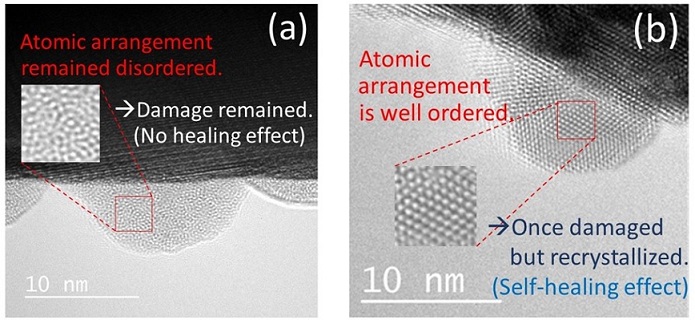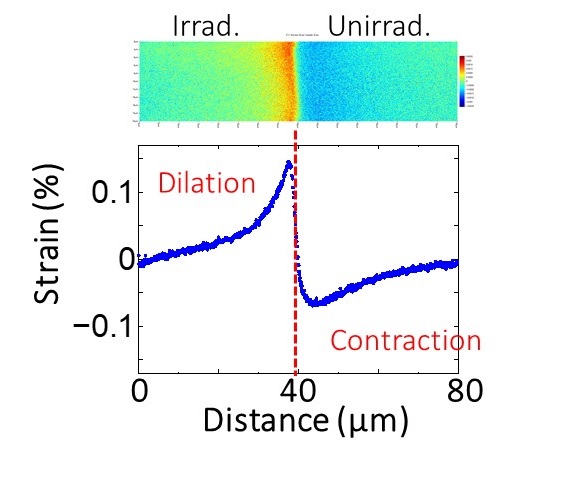
Due to nuclear fissions, high-energy fission products are generated in nuclear ceramics fuel. Such swift heavy nuclear fragments cause severe radiation damage inside nuclear ceramics fuels.
The objectives of our study are to predict radiation damage behavior in an accurate way and to develop radiation-resistant ceramics through research on radiation damage mechanism. In order to understand complicated process of radiation damage in nuclear reactor, large-scale ion accelerators are used. We can emulate fission condition by systematically varying ion irradiation condition and irradiation target materials. To understand micro- and nano-structure formation during radiation damage, transmission electron microscopy (TEM) and scanning electron microscopy (SEM) techniques are used. Studies are conducted based on the following two strategies.
Our recent study shows that lattice structure of certain ceramics is immediately recovered even if lattice structure is completely disordered after radiation damage. Our conventional understanding was that radiation damage in ceramics act as a driving force to form disorder of atomic lattice structure. However, after extensive study of radiation-resistant ceramics, it is found that certain ceramics inherently possess self-healing capability of rearranging the lattice structure.
For example, as shown in Fig. 1 (a) lattice structure is completely disordered in many of the ceramics irradiated with swift heavy ions. On the other hand, as shown in Fig. 1 (b) the lattice structure is reconstructed, for example, in BaF2 even after the damaging process. If this capability is enhanced by further study, it is expected that highly radiation-resistant materials can be developed in near future.

Fig.1 TEM images of (a) Y3Fe5O12 irradiated with swift heavy ions and (b) BaF2 irradiated with swift heavy ions. (Figures are reproduced from the figures cited from Ref.[2].)
References
[1] N. Ishikawa et al., "Experimental evidence of crystalline hillocks created by irradiation of CeO2 with swift heavy ions: TEM study", Nanotechnology 26 (2015) 355701.
[2] N. Ishikawa et al., "Hillocks created for amorphizable and nonamorphizable ceramics irradiated with swift heavy ions: TEM study", Nanotechnology 28 (2017) 445708.
[3] N. Ishikawa et al., " TEM analysis of ion tracks and hillocks produced by swift heavy ions of different velocities in Y3Fe5O12", J. Appl. Phys. 127, 055902 (2020).
Crystal deformation due to radiation damage can be characterized by using Electron backscatter diffraction (EBSD) technique. It enables us to understand the 3-dimensional crystal deformation during ion irradiation. The way crystals are deformed depends on the type of ceramics. It is possible that radiation-resistant ceramics respond to radiation in unique way. Characterization in terms of crystal deformation using EBSD technique opens up new frontier of radiation damage study.

Fig.2 Sapphire single crystal is partially irradiated with 340 MeV Au ion beam. The specimen is analyzed by using EBSD technique, and mapping of crystal strain in the horizontal direction is shown. Although irradiation was performed in spatially homogenous way, inhomogeneous strain distribution is recognizable.